At the end of every beer game, a debriefing recap is available displaying individual and team results. This provides an excellent opportunity for all participants. Players can understand and truly appreciate the value of the overall experience, while instructors use the debriefing session to introduce theoretical concepts within supply chain management and/or company projects and initiatives.
Additionally, the recap is available for download in PDF or Excel formats for both players and instructors to analyze further at a later date.
Here we’ll provide some suggestions and sample illustrations to help guide you through a typical debriefing, which generally occur through the following order of topics:
Designating a winner
Charts for analysis and discussion
Identifying areas for improvement
Concluding the game and introducing future concepts
For a practical application of the tips below, we have put together some slides to be displayed directly or integrated in your own deck : Download the Debriefing slides here (.pptx)
Watch our complete webinar "How to host a Beer Game session?

1. Designating a winner
The beer game is more fun when several teams compete with each other. In order to select a winner (using the default settings), we calculate the sum of the Inventory and Backorder Costs. The winning team will have reduced both costs and, therefore, achieved just the right stock level at each stage — not too high and not too low.
You can compare the results of all the teams on the "Results" page of each session.
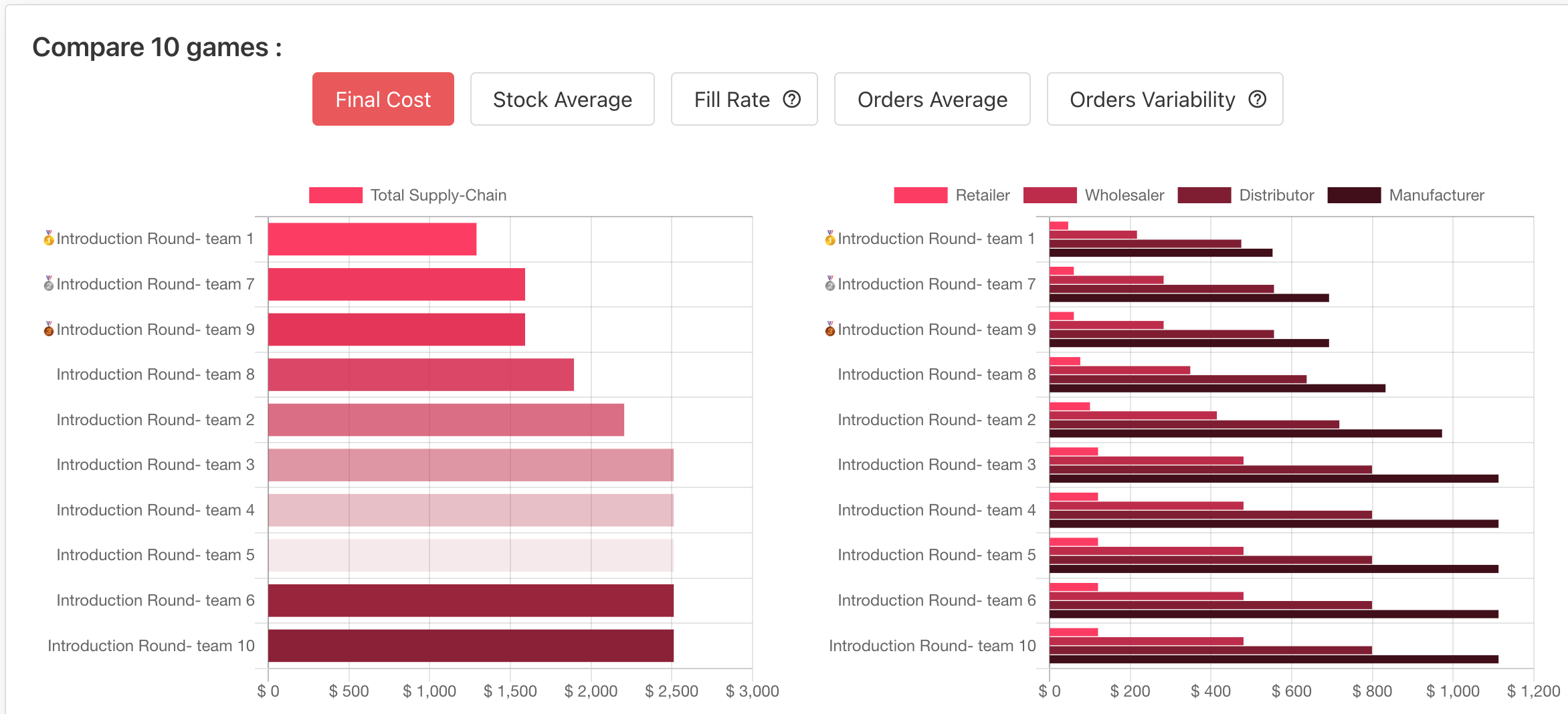
Compare the performance of dozens of games side-by-side
For players coming from Sales and Marketing departments, you also have the option to add a Unit Price to your product in the last stage — the retailer, for example. Every unit sold will then generate profit. The team who makes the most overall profit will be designated the winner.
 Compare the profit (revenue minus cost) of several games
Compare the profit (revenue minus cost) of several games
2. Charts for analysis and discussion
The best way to reinforce a lesson is to let players actively participate in analysis and discussion and come up with conclusions by themselves. To spark the discussion, you can display charts and pose questions to the whole class or to specific players/teams.
The first graph that you see in the recap displays the general evolution of game metrics at each turn.
 General game evolution
General game evolution
Here are some typical questions instructors might ask to begin a discussion:
At what point in the game did we generate the most costs? When was there a lot of stock or backorders?
Did you generally feel in control of the situation?
What difficulties did you meet throughout the game?
Next, the instructor can zoom in on The Order vs. Sell-out chart, which allows the comparison of final consumer demand and orders in the supply chain and reveals huge fluctuations and lack of coherence between the two.
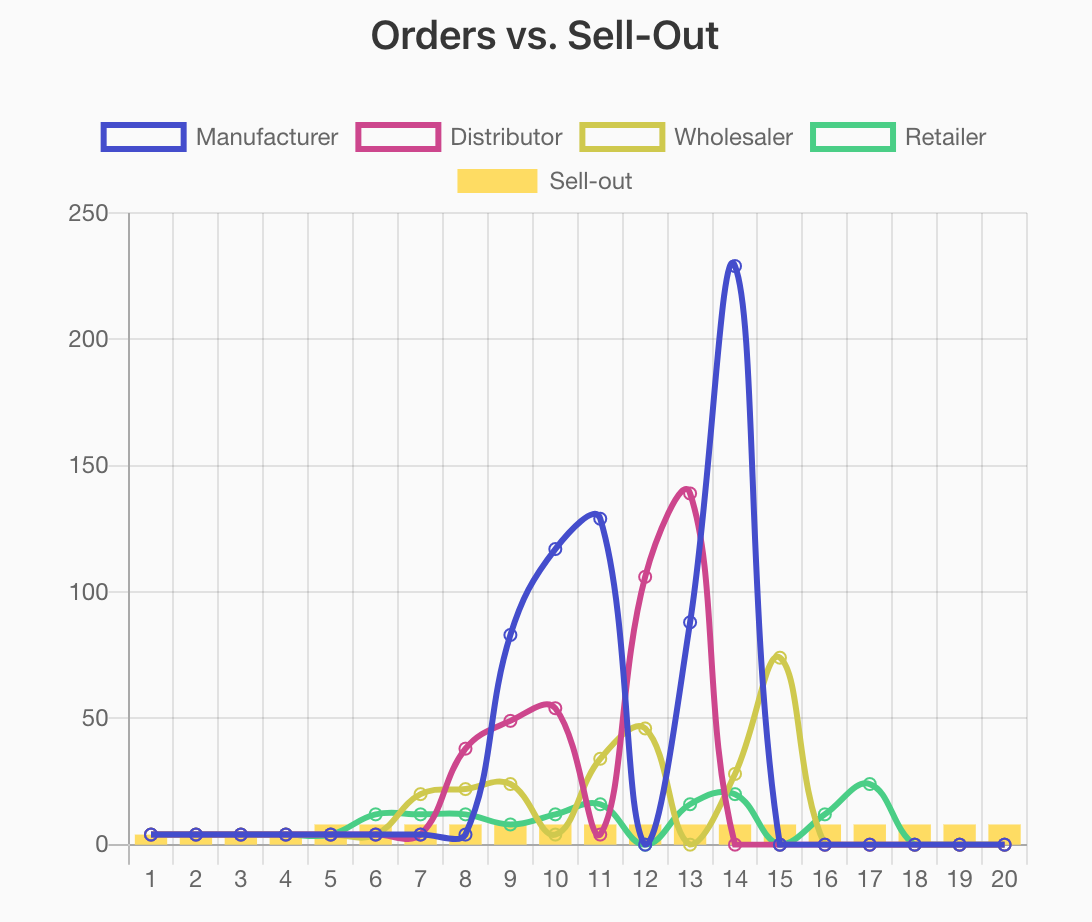
Here the instructor can ask: “How do you compare the final demand (“sell-out”) with the supply chain orders?”
In addition, you can view the facility evolution to see how fluctuations increase as we move up the chain from retailer to manufacturer:
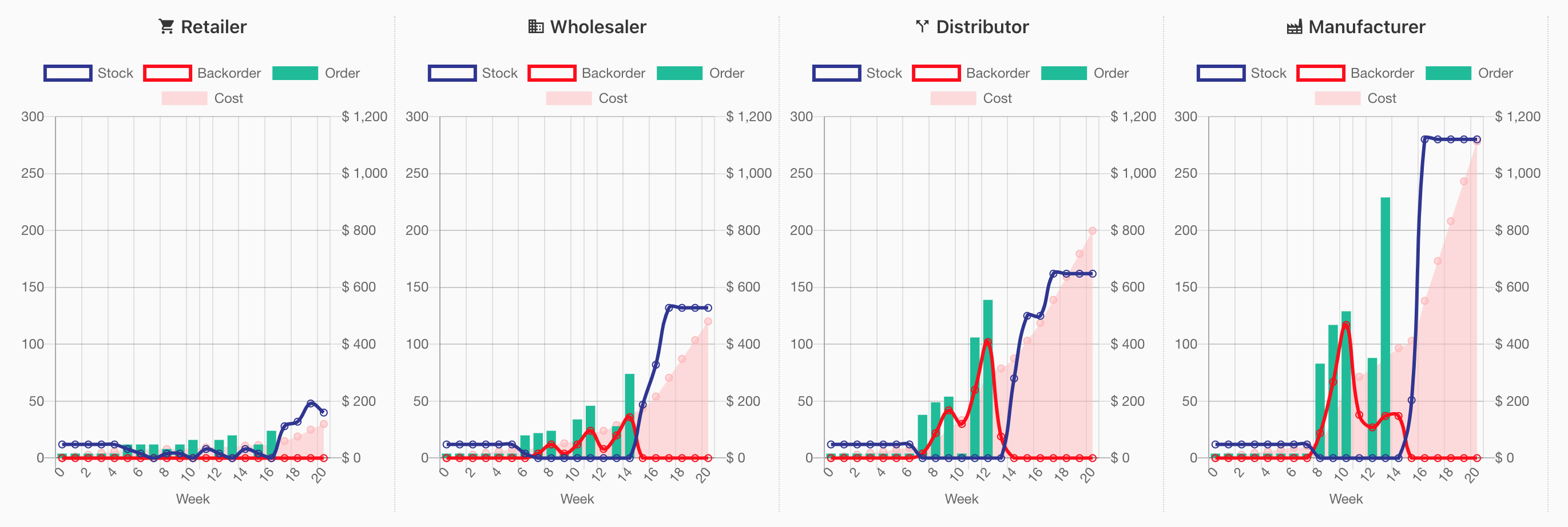 This is where you can illustrate the phenomenon called the “Bullwhip effect”.
This is where you can illustrate the phenomenon called the “Bullwhip effect”.
Looking at specific stages, instructors can ask players what they think may have led to this and will often receive the following explanations:
“I didn’t have any visibility on future demand.”
“I ordered more to ensure a safe level of stock.”
“My supplier didn’t deliver so I increased my orders.”
“I was afraid that I wouldn’t have enough stock.”
“I started to have backorders so I increased my orders to be safe.”
“My customer suddenly increased his orders.”
“The Lead Time didn’t allow me to react quickly enough.”
“I tried to optimize my own stock.”
“I lost count of how much I had ordered before.”
3. Identifying areas for improvement
Just remember that even though the game was designed to lead to these results, the challenges are not insurmountable!
Therefore, you can ask the participants to propose four pragmatic solutions to help reduce this effect and improve the results.
Here are just some common responses (with resulting lessons in parentheses):
“Communicate more and build a strategy.” (information sharing/collaboration)
“Project future sales to order/plan in advance.” (demand forecasts)
“Reduce lead times to be able to re-supply more quickly between both ends of the supply chain.” (improve performance)
“Reduce the number of stages by shipping from manufacturer to retailer.” (supply-chain design)
“Re-order only what is needed to keep a minimum stock at each stage and avoid peaks.” (planning tools/kanban)
If you want, you can even conduct a second round of the beer game integrating the propositions, for example:
Activate the “transparent mode” to allow participants to see each other's data.
Allow them to speak or chat with each-other if you choose.
Reduce the lead time, number of stages, or give approximate indications on the future demand to let them anticipate and build a strategy together.
These adjustments usually have a tremendous impact on the bottom line.
4. Concluding the game and introducing new concepts
Since the beer game simplifies any kind of supply chain, it is the perfect way to introduce additional concepts and projects. If you are working in a company, compare the rules and the layout with your own situation and tools. What are the similarities and differences?
In addition, the beer game can reveal deeply ingrained human biases and behaviors. It is good to be conscious of them so as to prevent issues in future client/supplier relationships.
Also, whether you wish to explain supply chain planning tools in use or have a project to introduce new ones, the beer game can effectively show how these can be useful by demonstrating supply chain challenges.
More specifically, the debriefing is the perfect time to introduce new concepts, which may be addressed later, such as:
Replenishment policies and calculations,
MRP / DDMRP systems,
Demand Forecasting methods
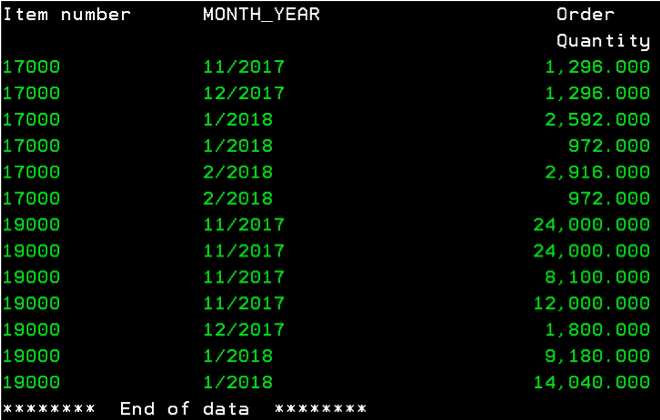 MRP calculation in an old "AS400" system
MRP calculation in an old "AS400" system
You can also introduce other trending topics that can improve the flexibility and performance of the supply chain, such as:
Demand Sensing
AI for forecasting/optimization
Industry 4.0
Even if the beer game is being conducted in outside areas like Marketing or Business, the game can reveal and detail connections to supply chains. For example, how do marketing and promotional activities impact operations, and which processes can help?
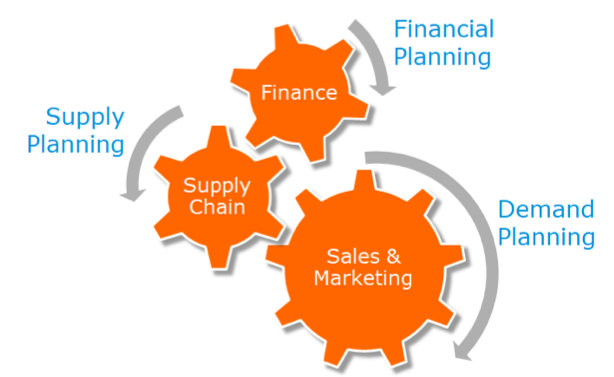 Sales and Operations Planning
Sales and Operations Planning
This being a general guide on how to conduct a debriefing session with Zensimu's Beer Game, please contact us if you have any specific questions within your specialized area not covered above.
Would you like to test a Beer Game simulation?
Please contact us if you have any specific questions within your specialized area not covered above


